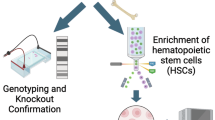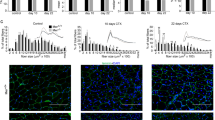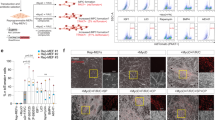Abstract
Oncostatin M (OSM) is a cytokine of the interleukin-6 family and plays important roles during inflammation. However, its roles in myoblast differentiation and muscle regeneration remain unexplored. We show here that OSM potently inhibited myoblast differentiation mainly by activating the JAK1/STAT1/STAT3 pathway. OSM downregulated myocyte enhancer-binding factor 2A (MEF2A), upregulated the expression of Id1 and Id2, and inhibited the transcriptional activity of MyoD and MEF2. In addition, OSM also enhanced the expression of STAT3 and OSM receptor, which constituted a positive feedback loop to further amplify OSM-induced signaling. Moreover, we found that STAT1 physically associated with MEF2 and repressed its transcriptional activity, which could account for the OSM-mediated repression of MEF2. Although undetectable in normal muscles in vivo, OSM was rapidly induced on muscle injury and then promptly downregulated just before the majority of myoblasts differentiate. Prolonged expression of OSM in muscles compromised the regeneration process without affecting myoblast proliferation, suggesting that OSM functions to prevent proliferating myoblasts from premature differentiation during the early phase of muscle regeneration.
Similar content being viewed by others
Log in or create a free account to read this content
Gain free access to this article, as well as selected content from this journal and more on nature.com
or
References
Buckingham M . Skeletal muscle formation in vertebrates. Curr Opin Genet Dev 2001; 11:440–448.
Puri PL, Sartorelli V . Regulation of muscle regulatory factors by DNA-binding, interacting proteins, and post-transcriptional modifications. J Cell Physiol 2000; 185:155–173.
Sabourin LA, Rudnicki MA . The molecular regulation of myogenesis. Clin Genet 2000; 57:16–25.
Arnold HH, Braun T . Targeted inactivation of myogenic factor genes reveals their role during mouse myogenesis: a review. Int J Dev Biol 1996; 40:345–353.
Tapscott SJ . The circuitry of a master switch: Myod and the regulation of skeletal muscle gene transcription. Development 2005; 132:2685–2695.
Weintraub H . The MyoD family and myogenesis: redundancy, networks, and thresholds. Cell 1993; 75:1241–1244.
Black BL, Olson EN . Transcriptional control of muscle development by myocyte enhancer factor-2 (MEF2) proteins. Annu Rev Cell Dev Biol 1998; 14:167–196.
Potthoff MJ, Olson EN . MEF2: a central regulator of diverse developmental programs. Development 2007; 134:4131–4140.
Berkes CA, Tapscott SJ . MyoD and the transcriptional control of myogenesis. Semin Cell Dev Biol 2005; 16:585–595.
Lassar AB, Davis RL, Wright WE, et al. Functional activity of myogenic HLH proteins requires hetero-oligomerization with E12/E47-like proteins in vivo. Cell 1991; 66:305–315.
Benezra R, Davis RL, Lockshon D, Turner DL, Weintraub H . The protein Id: a negative regulator of helix-loop-helix DNA binding proteins. Cell 1990; 61:49–59.
Molkentin JD, Black BL, Martin JF, Olson EN . Cooperative activation of muscle gene expression by MEF2 and myogenic bHLH proteins. Cell 1995; 83:1125–1136.
Molkentin JD, Olson EN . Defining the regulatory networks for muscle development. Curr Opin Genet Dev 1996; 6:445–453.
Charge SB, Rudnicki MA . Cellular and molecular regulation of muscle regeneration. Physiol Rev 2004; 84:209–238.
Shi X, Garry DJ . Muscle stem cells in development, regeneration, and disease. Genes Dev 2006; 20:1692–1708.
Tidball JG . Inflammatory processes in muscle injury and repair. Am J Physiol Regul Integr Comp Physiol 2005; 288:R345–R353.
Buckingham M . Myogenic progenitor cells and skeletal myogenesis in vertebrates. Curr Opin Genet Dev 2006; 16:525–532.
Buckingham M . Skeletal muscle progenitor cells and the role of Pax genes. C R Biol 2007; 330:530–533.
Dhawan J, Rando TA . Stem cells in postnatal myogenesis: molecular mechanisms of satellite cell quiescence, activation and replenishment. Trends Cell Biol 2005; 15:666–673.
Le Grand F, Rudnicki MA . Skeletal muscle satellite cells and adult myogenesis. Curr Opin Cell Biol 2007; 19:628–633.
Morgan JE, Partridge TA . Muscle satellite cells. Int J Biochem Cell Biol 2003; 35:1151–1156.
Wagers AJ, Conboy IM . Cellular and molecular signatures of muscle regeneration: current concepts and controversies in adult myogenesis. Cell 2005; 122:659–667.
Toumi H, F'Guyer S, Best TM . The role of neutrophils in injury and repair following muscle stretch. J Anat 2006; 208:459–470.
Brack AS, Conboy IM, Conboy MJ, Shen J, Rando TA . A temporal switch from notch to Wnt signaling in muscle stem cells is necessary for normal adult myogenesis. Cell Stem Cell 2008; 2:50–59.
Conboy IM, Rando TA . The regulation of Notch signaling controls satellite cell activation and cell fate determination in postnatal myogenesis. Dev Cell 2002; 3:397–409.
Le Grand F, Jones AE, Seale V, Scime A, Rudnicki MA . Wnt7a activates the planar cell polarity pathway to drive the symmetric expansion of satellite stem cells. Cell Stem Cell 2009; 4:535–547.
Fasnacht N, Muller W . Conditional gp130 deficient mouse mutants. Semin Cell Dev Biol 2008; 19:379–384.
Heinrich PC, Behrmann I, Haan S, Hermanns HM, Muller-Newen G, Schaper F . Principles of interleukin (IL)-6-type cytokine signalling and its regulation. Biochem J 2003; 374:1–20.
Kami K, Morikawa Y, Sekimoto M, Senba E . Gene expression of receptors for IL-6, LIF, and CNTF in regenerating skeletal muscles. J Histochem Cytochem 2000; 48:1203–1213.
Kami K, Senba E . Localization of leukemia inhibitory factor and interleukin-6 messenger ribonucleic acids in regenerating rat skeletal muscle. Muscle Nerve 1998; 21:819–822.
Kurek JB, Nouri S, Kannourakis G, Murphy M, Austin L . Leukemia inhibitory factor and interleukin-6 are produced by diseased and regenerating skeletal muscle. Muscle Nerve 1996; 19:1291–1301.
Chen SH, Benveniste EN . Oncostatin M: a pleiotropic cytokine in the central nervous system. Cytokine Growth Factor Rev 2004; 15:379–391.
Ichihara M, Hara T, Kim H, Murate T, Miyajima A . Oncostatin M and leukemia inhibitory factor do not use the same functional receptor in mice. Blood 1997; 90:165–173.
Walker EC, McGregor NE, Poulton IJ, et al. Oncostatin M promotes bone formation independently of resorption when signaling through leukemia inhibitory factor receptor in mice. J Clin Invest 2010; 120: 582–592.
Blau HM, Chiu CP, Webster C . Cytoplasmic activation of human nuclear genes in stable heterocaryons. Cell 1983; 32:1171–1180.
Yaffe D, Saxel O . Serial passaging and differentiation of myogenic cells isolated from dystrophic mouse muscle. Nature 1977; 270:725–727.
Beauchamp JR, Heslop L, Yu DS, et al. Expression of CD34 and Myf5 defines the majority of quiescent adult skeletal muscle satellite cells. J Cell Biol 2000; 151:1221–1234.
Cooper RN, Tajbakhsh S, Mouly V, Cossu G, Buckingham M, Butler-Browne GS . In vivo satellite cell activation via Myf5 and MyoD in regenerating mouse skeletal muscle. J Cell Sci 1999; 112:2895–2901.
Cornelison DD, Wold BJ . Single-cell analysis of regulatory gene expression in quiescent and activated mouse skeletal muscle satellite cells. Dev Biol 1997; 191:270–283.
Yablonka-Reuveni Z, Rivera AJ . Temporal expression of regulatory and structural muscle proteins during myogenesis of satellite cells on isolated adult rat fibers. Dev Biol 1994; 164:588–603.
Sun L, Ma K, Wang H, et al. JAK1-STAT1-STAT3, a key pathway promoting proliferation and preventing premature differentiation of myoblasts. J Cell Biol 2007; 179:129–138.
Ihle JN, Kerr IM . Jaks and Stats in signaling by the cytokine receptor superfamily. Trends Genet 1995; 11:69–74.
Mertens C, Darnell JE Jr . SnapShot: JAK-STAT signaling. Cell 2007; 131:612.
Ichiba M, Nakajima K, Yamanaka Y, Kiuchi N, Hirano T . Autoregulation of the Stat3 gene through cooperation with a cAMP-responsive element-binding protein. J Biol Chem 1998; 273:6132–6138.
Nakajima K, Yamanaka Y, Nakae K, et al. A central role for Stat3 in IL-6-induced regulation of growth and differentiation in M1 leukemia cells. EMBO J 1996; 15:3651–3658.
Narimatsu M, Maeda H, Itoh S, et al. Tissue-specific autoregulation of the stat3 gene and its role in interleukin-6-induced survival signals in T cells. Mol Cell Biol 2001; 21:6615–6625.
Wagner BJ, Hayes TE, Hoban CJ, Cochran BH . The SIF binding element confers sis/PDGF inducibility onto the c-fos promoter. EMBO J 1990; 9:4477–4484.
Chung CD, Liao J, Liu B, et al. Specific inhibition of Stat3 signal transduction by PIAS3. Science 1997; 278:1803–1805.
Favata MF, Horiuchi KY, Manos EJ, et al. Identification of a novel inhibitor of mitogen-activated protein kinase kinase. J Biol Chem 1998; 273:18623–18632.
Bennett AM, Tonks NK . Regulation of distinct stages of skeletal muscle differentiation by mitogen-activated protein kinases. Science 1997; 278:1288–1291.
Coolican SA, Samuel DS, Ewton DZ, McWade FJ, Florini JR . The mitogenic and myogenic actions of insulin-like growth factors utilize distinct signaling pathways. J Biol Chem 1997; 272:6653–6662.
Wu Z, Woodring PJ, Bhakta KS, et al. p38 and extracellular signal-regulated kinases regulate the myogenic program at multiple steps. Mol Cell Biol 2000; 20:3951–3964.
Miyake T, Alli NS, Aziz A, et al. Cardiotrophin-1 maintains the undifferentiated state in skeletal myoblasts. J Biol Chem 2009; 284:19679–19693.
Cheng TC, Wallace MC, Merlie JP, Olson EN . Separable regulatory elements governing myogenin transcription in mouse embryogenesis. Science 1993; 261:215–218.
Yee SP, Rigby PW . The regulation of myogenin gene expression during the embryonic development of the mouse. Genes Dev 1993; 7:1277–1289.
Morin S, Charron F, Robitaille L, Nemer M . GATA-dependent recruitment of MEF2 proteins to target promoters. EMBO J 2000; 19:2046–2055.
Xu Q, Wu Z . The insulin-like growth factor-phosphatidylinositol 3-kinase-Akt signaling pathway regulates myogenin expression in normal myogenic cells but not in rhabdomyosarcoma-derived RD cells. J Biol Chem 2000; 275:36750–36757.
Molkentin JD, Firulli AB, Black BL, et al. MEF2B is a potent transactivator expressed in early myogenic lineages. Mol Cell Biol 1996; 16:3814–3824.
Morisaki T, Sermsuvitayawong K, Byun SH, et al. Mouse Mef2b gene: unique member of MEF2 gene family. J Biochem 1997; 122:939–946.
Ornatsky OI, McDermott JC . MEF2 protein expression, DNA binding specificity and complex composition, and transcriptional activity in muscle and non-muscle cells. J Biol Chem 1996; 271:24927–24933.
Kataoka Y, Matsumura I, Ezoe S, et al. Reciprocal inhibition between MyoD and STAT3 in the regulation of growth and differentiation of myoblasts. J Biol Chem 2003; 278:44178–44187.
Sironi JJ, Ouchi T . STAT1-induced apoptosis is mediated by caspases 2, 3, and 7. J Biol Chem 2004; 279:4066–4074.
Yan Z, Choi S, Liu X, et al. Highly coordinated gene regulation in mouse skeletal muscle regeneration. J Biol Chem 2003; 278:8826–8836.
Modur V, Feldhaus MJ, Weyrich AS, et al. Oncostatin M is a proinflammatory mediator. In vivo effects correlate with endothelial cell expression of inflammatory cytokines and adhesion molecules. J Clin Invest 1997; 100:158–168.
Mozaffarian A, Brewer AW, Trueblood ES, et al. Mechanisms of oncostatin M-induced pulmonary inflammation and fibrosis. J Immunol 2008; 181:7243–7253.
Wallace PM, MacMaster JF, Rouleau KA, et al. Regulation of inflammatory responses by oncostatin M. J Immunol 1999; 162:5547–5555.
Morikawa Y, Tamura S, Minehata K, Donovan PJ, Miyajima A, Senba E . Essential function of oncostatin m in nociceptive neurons of dorsal root ganglia. J Neurosci 2004; 24:1941–1947.
Tanaka M, Hirabayashi Y, Sekiguchi T, Inoue T, Katsuki M, Miyajima A . Targeted disruption of oncostatin M receptor results in altered hematopoiesis. Blood 2003; 102:3154–3162.
Korzus E, Nagase H, Rydell R, Travis J . The mitogen-activated protein kinase and JAK-STAT signaling pathways are required for an oncostatin M-responsive element-mediated activation of matrix metalloproteinase 1 gene expression. J Biol Chem 1997; 272:1188–1196.
Li WQ, Dehnade F, Zafarullah M . Oncostatin M-induced matrix metalloproteinase and tissue inhibitor of metalloproteinase-3 genes expression in chondrocytes requires Janus kinase/STAT signaling pathway. J Immunol 2001; 166:3491–3498.
Nakamura K, Nonaka H, Saito H, Tanaka M, Miyajima A . Hepatocyte proliferation and tissue remodeling is impaired after liver injury in oncostatin M receptor knockout mice. Hepatology 2004; 39:635–644.
Serrano AL, Baeza-Raja B, Perdiguero E, Jardi M, Munoz-Canoves P . Interleukin-6 is an essential regulator of satellite cell-mediated skeletal muscle hypertrophy. Cell Metab 2008; 7:33–44.
Austin L, Bower J, Kurek J, Vakakis N . Effects of leukaemia inhibitory factor and other cytokines on murine and human myoblast proliferation. J Neurol Sci 1992; 112:185–191.
Barnard W, Bower J, Brown MA, Murphy M, Austin L . Leukemia inhibitory factor (LIF) infusion stimulates skeletal muscle regeneration after injury: injured muscle expresses lif mRNA. J Neurol Sci 1994; 123:108–113.
Kurek JB, Bower JJ, Romanella M, Koentgen F, Murphy M, Austin L . The role of leukemia inhibitory factor in skeletal muscle regeneration. Muscle Nerve 1997; 20:815–822.
Megeney LA, Perry RL, LeCouter JE, Rudnicki MA . bFGF and LIF signaling activates STAT3 in proliferating myoblasts. Dev Genet 1996; 19:139–145.
Spangenburg EE, Booth FW . Multiple signaling pathways mediate LIF-induced skeletal muscle satellite cell proliferation. Am J Physiol Cell Physiol 2002; 283:C204–211.
Kim H, Jo C, Jang BG, Oh U, Jo SA . Oncostatin M induces growth arrest of skeletal muscle cells in G1 phase by regulating cyclin D1 protein level. Cell Signal 2008; 20:120–129.
Jo C, Kim H, Jo I, et al. Leukemia inhibitory factor blocks early differentiation of skeletal muscle cells by activating ERK. Biochim Biophys Acta 2005; 1743:187–197.
Sartorelli V, Huang J, Hamamori Y, Kedes L . Molecular mechanisms of myogenic coactivation by p300: direct interaction with the activation domain of MyoD and with the MADS box of MEF2C. Mol Cell Biol 1997; 17:1010–1026.
Wang H, Xu Q, Xiao F, Jiang Y, Wu Z . Involvement of the p38 mitogen-activated protein kinase alpha, beta, and gamma isoforms in myogenic differentiation. Mol Biol Cell 2008; 19:1519–1528.
Acknowledgements
We thank Dr Toru Ouchi for the STAT1c construct, and other members of the Wu laboratory for technical help and discussions. This project was supported by grants from Hong Kong Research Grant Council (N_HKUST621/08, HKUST6496/06M, 663308, HKUST1/06C to ZW) and an Area of Excellence Scheme (AoE/B-15/01) of the University Grants Council.
Author information
Authors and Affiliations
Corresponding author
Additional information
( Supplementary information is linked to the online version of the paper on the Cell Research website.)
Supplementary information
Supplementary information, Figure S1
Simultaneous inhibition of JAK1 and ERK reduced myoblast proliferation (PDF 130 kb)
Supplementary information, Figure S2
OSM treatment did not alter the stability of Id proteins. (PDF 37 kb)
Supplementary information, Figure S3
STAT1 interacted with and repressed MEF2 (PDF 80 kb)
Rights and permissions
About this article
Cite this article
Xiao, F., Wang, H., Fu, X. et al. Oncostatin M inhibits myoblast differentiation and regulates muscle regeneration. Cell Res 21, 350–364 (2011). https://doi.org/10.1038/cr.2010.144
Received:
Revised:
Accepted:
Published:
Issue date:
DOI: https://doi.org/10.1038/cr.2010.144
Keywords
This article is cited by
-
Induction of muscle stem cell quiescence by the secreted niche factor Oncostatin M
Nature Communications (2018)
-
Data-Modeling Identifies Conflicting Signaling Axes Governing Myoblast Proliferation and Differentiation Responses to Diverse Ligand Stimuli
Cellular and Molecular Bioengineering (2017)
-
The effect of palmitate supplementation on gene expression profile in proliferating myoblasts
Cell Biology and Toxicology (2016)



